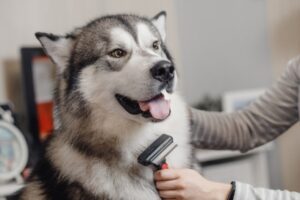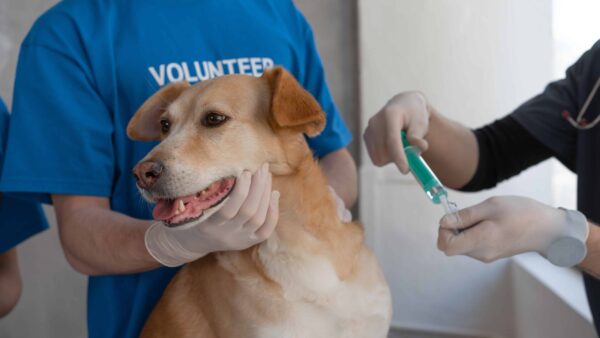As the flowers begin to bloom and temperatures rise, it’s not just humans who crave a springtime refresh; your furry companions are also in need of a thorough and professional grooming session to get rid of the accumulated dirt, dander, and thick winter coats.
The protective fur that kept your dog warm throughout the winter months becomes more of a burden as spring arrives. Therefore, it’s crucial to address these coats before they begin to shed excessively.
Spring marks the perfect time to bath your dog, especially after months of avoiding it due to the cold weather. It’s the ideal season to regularly brush your dog’s coat, as the thick and plush fur grown during winter can become uncomfortable.
The spring is also the best period to get your dog’s nails gently trimmed and clipped after overlooking them all through the winter.
To summarize everything above into a sentence, “The spring is the perfect period to groom dogs of all coat types, breeds, and sizes”.
To keep your pets looking best, healthy, and comfortable during the springtime, we have put together our list of the best spring grooming tips for dogs.
Read this article completely and get your dog ready to embrace the season with a wagging tail and a shiny coat.
Best Spring Grooming Tips for Dogs
Before going into detail, I would like to state that dogs are also capable of grooming themselves naturally.
Whenever your pup rolls on the ground, licks its fur, or nibbles gently on its coat, it’s cleaning itself naturally. However, this does not mean that grooming your dog regularly or visiting a professional dog groomer is unnecessary.
Especially during the Spring period, hygiene essentials such as regular brushing, deep cleaning baths (at least once every two months), teeth brushing, and nail trimming are all necessary.
It is also important to know that the intervals at which you groom your dog in spring depend on its breed. If you own a poodle, Bichon, Maltese, Shih Tzu, or Komondor, you will likely groom them frequently due to their long and coarse coats. However, if you own a dog with a short coat, you won’t need to groom them every single week.
With all these being said, let us look at the recommended and best spring grooming tips for dogs:
1. Give Your Dog A Thorough Bath

Under normal conditions, experts recommend bathing our dogs once every two months.
However, during the spring season, when pollen and allergens are more active, your dog may require more frequent bathing. Myers, a professional dog groomer, recommends bathing dogs every 21 days in Spring.
How To Properly Bathe Your Dog
Bathing your dog might seem straightforward but trust us when we say it is more than just getting your dog wet.
Below are some simple steps to give your furry friend a proper bath:
Step 1: Brush Your Dog’s Coat
Before bathing your dog, the first thing you should do is brush its fur to remove dead hairs and mats.
If you go ahead to bathe your dog while his hairs are tangled or knotted, it will make the knots tighter, and brushing them out will be hard and uncomfortable for your dog.
Step 2: Preparing the Bath
After brushing, the next step is to put your pup in a tub or sink already filled with lukewarm water (not more than four inches deep).
Not all dogs enjoy bathing. So, you may have to distract your dog by putting his favorite toys or chews in the tub. But if your dog loves to swim or bathe, you don’t need to do this while working on his fur.
Step 3: Use Recommended Shampoo
You may want to use shampoo if your dog’s coat is extremely dirty. We will recommend using hypoallergenic shampoo and Rinse Conditioner.
Pour the doggie shampoo on the fur and gently massage it into the fur. After massaging in a circular motion for 30 secs – 1 min. Rinse it off with water carefully and ensure water is not directly sprayed into their eyes or ears.
Step 4: Drying
This is the last step. After bathing your dog, pat them gently with a towel to remove excess water.
Avoid vigorous rubbing, as it can tangle their fur. Then, let them air dry or use a hairdryer in a low, cool setting. Keep the hairdryer at a safe distance away from their skin to prevent burns.
2. Brush Your Dog’s Coat

During the spring, dogs begin to shed their thick winter coat. To prevent excessive shedding, brush your dog regularly with recommended brushes.
Dogs with long and silky coats will require frequent grooming compared to the ones with short and dense coats.
A boar bristle brush is perfect for all coat types, it also helps to circulate the natural oil produced on the dog’s skin all over the coat. A shedding blade is perfect if you are working on the undercoat.
Wire pin brushes are perfect for dogs with very long, thick, and several coats (Golden Retrievers, Collies, Sheepdogs, etc.). We will also recommend using a slicker brush for matted dog coats and a bristle brush for smoothing a dog’s coat.
If you are handling a dog with a long coat, you may prefer combing to brushing him because combs generally have a longer bristle. You can easily get a grooming comb for your dog in a nearby pet store.
Below are the qualities of a good grooming brush or comb for dogs:
- They spread natural oils and help your dog maintain shiny and lustrous fur.
- They untangle the dog’s mat.
- They clean out dirt.
3. Hair Trimming
In the spring, dogs tend to shed a lot of fur. To keep your surroundings clean and your pup comfortable, consider giving their coat a trim.
By trimming your dog, you will keep the coat soft and free from tangles. You will also make him more comfortable because having a longer coat during warmer temperatures might be uncomfortable for your dog.
If you have decided to trim your dog’s coat, we recommend taking him to a professional groomer. Avoid cutting him at home with human clippers as this may harm or injure your dog.
4. Nail Trimming or Clipping
While you might have overlooked your dog’s nails during the winter, it is important to keep your dog’s nails short during the Spring.
Long nails can make your dog uncomfortable; it can cause difficulty in walking, and joint problems, and even lead to accidents or injuries for your pet. To prevent any of these from happening, trim your dog’s nails.
There is a widespread misconception regarding dog nails, particularly the belief that they contain arteries. The truth is, if you trim a nail too short, what you might see as bleeding is the “Kwik” of the nail. Fortunately, there are powders available to help stop this bleeding.
If your dog doesn’t enjoy clipping, you can opt for these hassle-free and natural methods of keeping dog nails short.
5. Clean Your Dog’s Ear
Your dog’s spring grooming session should also incorporate ear cleaning. However, you need to remember that dog ears are prone to irritation.
With that being said, ensure you clean their ears properly and occasionally. You may endeavor to check their ear once a month.
While cleaning your dog’s ear, avoid inserting cotton swabs to bring out the ear wax as this can irritate your dog’s ear.
The best technique is to clean the external part of the ear with a cotton bud or gauze. You may also make inquiries from dog groomers on the best methods to clean dog ears.
6. Dental Care

As a responsible dog owner, you have to keep your dog’s teeth healthy throughout the spring to avoid dangerous gum issues and bad breath.
You should always brush your dog’s teeth at least twice or three times a week to prevent plaque or bacterial buildup.
You may also get your dog chew toys to keep his teeth and gum healthy and clean.
Dogs do not like brushing but by following the technique below, you can maintain your dog’s dental health effortlessly.
All you need to do is familiarize your pup with brushing. Start by gently massaging the area around their mouth daily, making them comfortable with the sensation. Gradually progress to touching and massaging their teeth and gums.
Once your furry friend is at ease, introduce doggie toothpaste, allowing them to get accustomed to the taste. Then, introduce a toothbrush, using a circular motion primarily on the outer teeth surface, where plaque tends to accumulate.
7. Be Aware of Spring Allergies
While grooming your dog in the new season is necessary, you must be aware of seasonal allergies and how you can prevent them.
Spring brings not only blooming flowers and warmer weather but also a less-welcome visitor: Allergies.
Spring allergies in dogs are often triggered by pollen from trees, grasses, and flowers, which become more active during this time of year.
Some of the signs of spring allergies in dogs include itching, sneezing, watery eyes, runny nose, and skin irritations. In severe cases, allergies can lead to respiratory issues and discomfort.
To prevent your dog from allergies, below are the things you should do:
- Limit outdoor activities and take your dog for a walk only when pollens are less active (early in the morning and evening)
- Reduce allergens in your house by using air purifiers to purify your house.
- Provide your dog with balanced nutrition and supplements to help improve your dog’s immune system. You may also consult with your vet for medications such as antihistamines to alleviate allergy symptoms.
- Groom your dog regularly.
The DO’s and DON’Ts of Spring Grooming Sessions for Dogs

DO’s Of Grooming a Dog in Spring:
- Choose the right shampoo for your dog’s hair type and skin condition.
- Invest in high-quality brushes suitable for your dog’s hair and be gentle during brushing.
- Brush your dog coat before bathing to untie knots and tangles.
- Take precautions during baths to protect your dog’s eyes and ears.
- Rinse shampoo thoroughly to prevent skin irritation.
- Shampoo your dog twice for a deep clean.
- Wait until after playtime for a bath to keep your dog calm.
- Use oils, calming aids, and comfort toys to make baths positive experiences.
- Provide a comfy grooming space and invest in quality grooming tools.
DON’Ts Of Grooming a Dog in Spring:
- Don’t use shampoo not suited to your dog’s specific needs.
- Avoid brushing wet fur to prevent damage and discomfort.
- Don’t let water spray into your dog’s eyes and ears.
- Don’t leave shampoo residue on the skin.
- Avoid bathing without a walk, as tired dogs are more cooperative.
- Don’t create negative associations with baths; use positive reinforcement.
- Don’t compromise on grooming tools’ quality; invest in the best for your pup.
Conclusion
Spring is here. However, is your furry friend ready to enjoy the warmer weather? In this article, we have revealed the best spring grooming tips to ensure your dogs are healthy and comfortable during the spring.
By following these spring grooming tips for dogs, you can make sure your pets have a smooth transition into spring and stay happy throughout the season.







Leave a comment